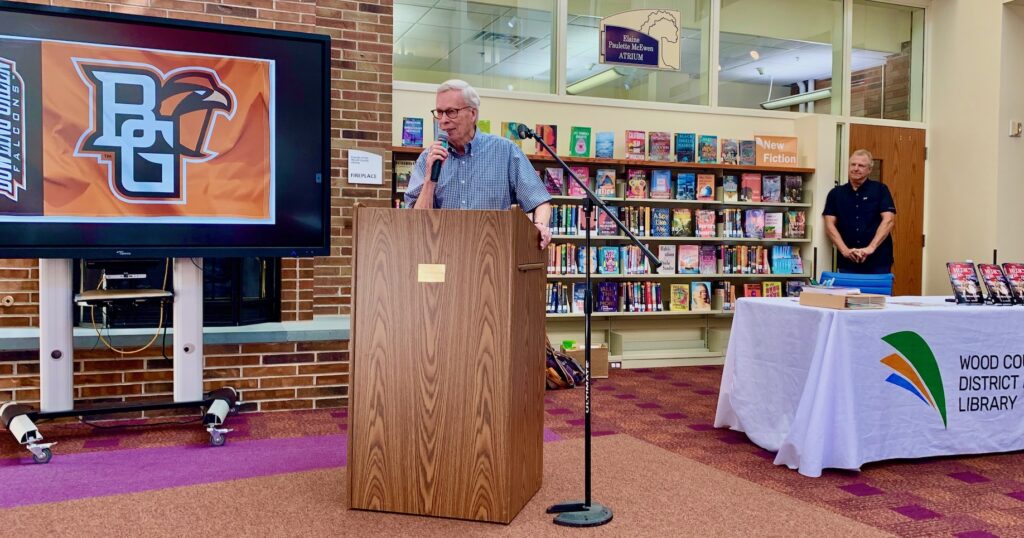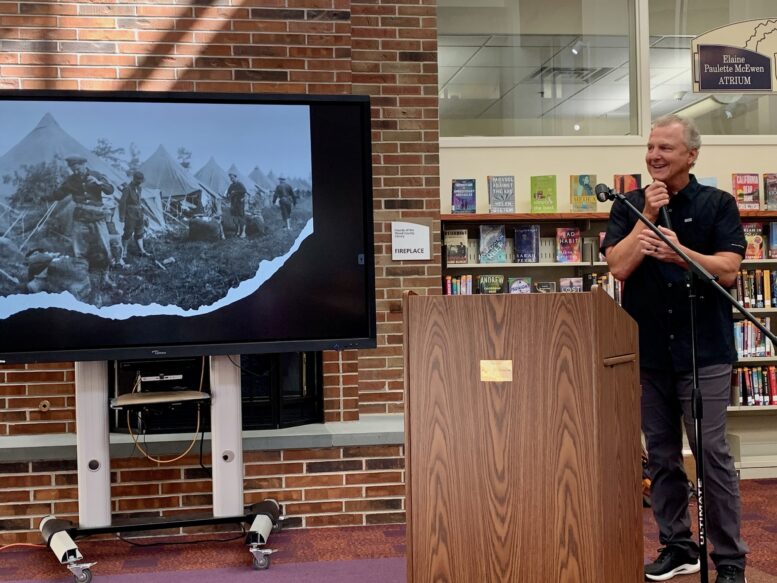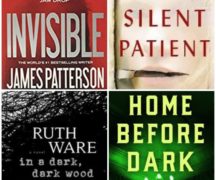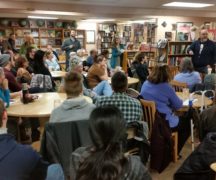By JULIE CARLE
BG Independent News
Ed Kruszynski’s book “The Medic’s Wife” didn’t start out to be a book; it started as a memoir written for the family about his father’s military service.
His father, Edmund Kruszynski, served as a medic in World War II, but neither he nor his wife, Mary Kruszynski, talked much about the war or Edmund’s service when young Ed and his siblings were growing up.
When Mary’s Brecksville, Ohio, house flooded in 2006, five years after her husband died, the vow of secrecy held tightly for decades between the couple started to waiver.
“The Medic’s Wife,” which is one of the top three sellers on Amazon’s WWII biographies list, follows the lives of Mary and Edmund before, during and after the war, said Ed Kruszynski at an author’s talk at the Wood County District Public Library on Thursday.
Reviews describe the book as “a story of altruism, bravery and leadership in the face of unimaginable adversity,” and” a powerful and deeply moving account of an American medic’s account as he bore witness to the horrors of the Holocaust.”
Ed goes on to explain, “This is about an American family and how war affects American families.”
He’s had many readers tell him the story helped them understand how their families operated during World War II and why their fathers did some of the things they did.
“The reason it resonates is because it answers some questions for people with their own family and parents,” he said. “It’s a book about fallen heroes and the families they leave behind.”
While writing the book, Ed realized the war “wasn’t a land-grab to right some wrongs like in World War I. It was an act of defiance against hatred.”
In the 1930s an ‘40s, Germany was burning books trying to change the natural order of history. “It’s not that long ago in my lifespan that this was happening,” he said.
The realization that it was a “war for humanity” hit him as he unpacked his father’s experiences from deployment to five different concentration camps including Dachau and Buchenwald.
Telling the story
Ed wasn’t planning to become a writer or an author; however, “The Medic’s Wife” has made him both, he said with a laugh. He grew up in the Cleveland area, came to Bowling Green State University, where he earned two business degrees, and met and married his Falcon Flame, Tracy Edwards. He worked for Procter & Gamble for 31 years where he had a track record of success.

He admitted the book would not have become a reality without Mary Kruszynski deciding at the age of 94 to make a personal, video testimonial about what happened during the war years. “She’s the real hero in this book,” he said.If she hadn’t decided to share the secret she had vowed to keep forever, Edmund’s story would have been lost forever.
Ed still shakes his head that they had no idea, not even after the flood brought to light the unknown box of treasured keepsakes.
“Every time we approached Mom about anything related to the war, she clammed up and wasn’t willing to talk about it,” he said.
After her death, with the discovery of her video, along with the letters, photos and journal, Ed knew he didn’t want his father’s service “to be another footnote in the industry.” With all the details in front of him, plus a lot of additional research, the book started to take shape.
He decided to use a literary formula, similar to the Titanic movie, that bookended “Old Rose” at the beginning and end of the story, with the middle part jumping back in time to tell about their young relationship.
In Ed’s split-time novel, the book begins and ends with “Old Mary” telling the story– though he said, “my mother would roll over if she heard me refer to her as ‘Old Mary.’”
The middle section of the book takes the reader through their courtship, marriage and Edmund’s wartime experience.
They met and fell in love in July 1940. Within six months, Edmund was drafted and by February 1941 he was sent to boot camp, where he would be trained for 18 months. Everything went well until the Japanese bombed Pearl Harbor on Dec. 7, 1941. Three months after Pearl Harbor, Edmund and Mary decided to marry, despite protests from their parents.
“Their view was, why wait? If I don’t come back, we’ve lost this chance to be together,” Ed learned. The 18-month assignment turned into five years.
Edmund was deployed overseas and on June 6, 1944, D-Day, he led a team of medics onto the beaches of Normandy for the first time to treat the wounded and get them to hospitals. He and his platoon landed on the beaches a total of eight different times.
“For me, this was probably the most emotional part of the book,” Ed said. “Even though I’m in my 60s, I’m still his son and he’s still my dad.” All too familiar with the deadly scenes of D-Day depicted in films, Ed was stunned to learn of his father’s involvement.
“How shrapnel never made it onto the bodies of the soldiers on those boats is flabbergasting,” he said.
Edmund’s platoon wasn’t as fortunate in their work in March 1945 when they were headed into Germany after the allies had won the supply lines.
“This was when tragedy hits,” Ed said. One of Edmund’s closest friends was killed as they were trying to cross a bridge. “One second he was there, the next second he was gone,” he wrote in his journal.
At about the same time, there were whispers about what was going on in the German prisons.
After Hitler’s death, the war was over, but the young medics were deployed to the concentration camps to help the prisoners. Edmund kept a detailed map of his travels, and on April 17, 1945, he entered Buchenwald.
“What he finds there is really disturbing, and he writes a detailed letter of what he saw,” Ed said. The letter was never mailed because he couldn’t share the gruesomeness of what they saw; instead, he tucked it into his journal.
He finally went home in October 1945 with five bronze combat stars, a silver combat star, a meritorious achievement award for his platoon, and serious post-traumatic stress disorder. Disturbed by the reality that not everyone in his platoon made it back, he returned home, but the war stayed with him.
A catastrophic event came close to ending their marriage, Ed said. Mary’s “tough love” with Edmund was an ultimatum that he needed to share everything that went on so together they could move past the trauma.
“I give my dad a lot of credit. A lot of men wouldn’t do that,” he said.
The next day, Edmund went through everything with Mary for eight or nine hours. “It’s not what they saw in the war that bothered him the most, it’s the decisions they made that affected other people, especially when they don’t come back,” Ed said.
The vow is broken
With the stories shared, Mary vowed to keep his secrets. And she did until she was 94 years old and living in an assisted care facility. Maggie O’Sullivan, her best friend and confidante in the same community convinced her to share Edmund’s story as part of their local library’s World War II History Project. The library was only interested in the veterans telling their stories, not their family members.
Mary and Maggie took matters into their own hands and recorded their own videos using a smartphone. Maggie asked the questions, and Mary revealed the WWII stories of her beloved Edmund.
Mary tells her story and breaks her vow of silence in the video testimonial. She includes a letter written to her by Edmund’s commanding officer in November 1945. “That husband of yours is the best platoon sergeant in the Army in one of the best platoons in the Army. Only about 40 people know this, and I’m glad to be one of those,” the officer wrote.
She struggled with how to end the video but came up with her closing statement” “I attest this to be a true account. My name is Mary Kruszyski, and I am the medic’s wife.”
The book, which was published a year ago, has received its own following. Ed surmised that many WWII books are written about infantry or famous people in the war rather than about medics.
“The Medic’s Wife” is also ranked number three for Holocaust biographies “even though my dad was not a survivor. He’s a gentile. Instead of being a book about a Holocaust survivor, it is a book where an objective American came into five different camps and described what he saw,” Ed said. “It is a powerful reminder that we must never forget the atrocities committed during the darkest chapter of the history and that we must always strive to ensure that such horrors never happen again.”
“The Medic’s Wife,” published by Hellgate Press, is available on Amazon and at other booksellers.





